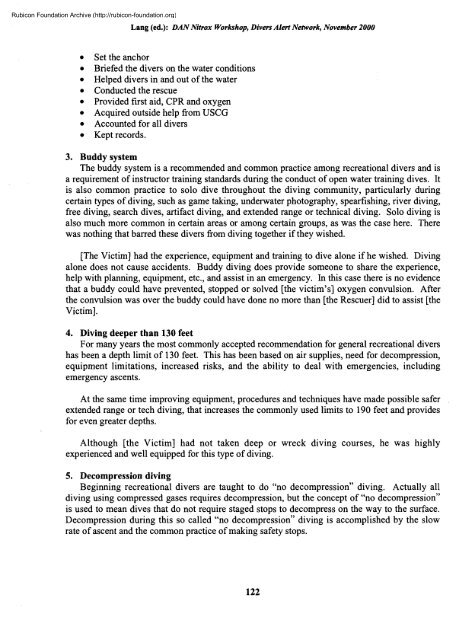Nitrox workshop dings - Divers Alert Network
Nitrox workshop dings - Divers Alert Network
Nitrox workshop dings - Divers Alert Network
Create successful ePaper yourself
Turn your PDF publications into a flip-book with our unique Google optimized e-Paper software.
Rubicon Foundation Archive (http://rubicon-foundation.org)Lang (ed.): DAN<strong>Nitrox</strong> Workshop, <strong>Divers</strong> <strong>Alert</strong> <strong>Network</strong>, November 2000• Set the anchor• Briefed the divers on the water conditions• Helped divers in and out of the water• Conducted the rescue• Provided first aid, CPR and oxygen• Acquired outside help from USCG• Accounted for all divers• Kept records.3. Buddy systemThe buddy system is a recommended and common practice among recreational divers and isa requirement of instructor training standards during the conduct of open water training dives. Itis also common practice to solo dive throughout the diving community, particularly duringcertain types of diving, such as game taking, underwater photography, spearfishing, river diving,free diving, search dives, artifact diving, and extended range or technical diving. Solo diving isalso much more common in certain areas or among certain groups, as was the case here. Therewas nothing that barred these divers from diving together if they wished.[The Victim] had the experience, equipment and training to dive alone if he wished. Divingalone does not cause accidents. Buddy diving does provide someone to share the experience,help with planning, equipment, etc., and assist in an emergency. In this case there is no evidencethat a buddy could have prevented, stopped or solved [the victim's] oxygen convulsion. Afterthe convulsion was over the buddy could have done no more than [the Rescuer] did to assist [theVictim].4. Diving deeper than 130 feetFor many years the most commonly accepted recommendation for general recreational divershas been a depth limit of 130 feet. This has been based on air supplies, need for decompression,equipment limitations, increased risks, and the ability to deal with emergencies, includingemergency ascents.At the same time improving equipment, procedures and techniques have made possible saferextended range or tech diving, that increases the commonly used limits to 190 feet and providesfor even greater depths.Although [the Victim] had not taken deep or wreck diving courses, he was highlyexperienced and well equipped for this type of diving.5. Decompression divingBeginning recreational divers are taught to do "no decompression" diving. Actually alldiving using compressed gases requires decompression, but the concept of "no decompression"is used to mean dives that do not require staged stops to decompress on the way to the surface.Decompression during this so called "no decompression" diving is accomplished by the slowrate of ascent and the common practice of making safety stops.122
















